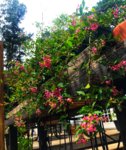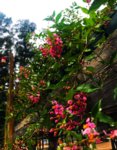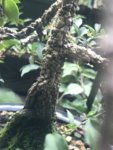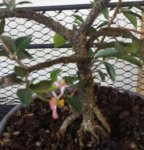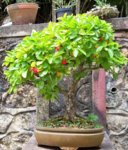You are using an out of date browser. It may not display this or other websites correctly.
You should upgrade or use an alternative browser.
You should upgrade or use an alternative browser.
Barbados cherry flowers.
- Thread starter Crassula king
- Start date
Anthony
Imperial Masterpiece
Looks like it might be - https://en.wikipedia.org/wiki/Malpighia_emarginata
Used to be Malpighia Glabra.
Good Day
Anthony
Used to be Malpighia Glabra.
Good Day
Anthony
LanceMac10
Imperial Masterpiece
Velodog2
Chumono
The kind that has flowers smelling of laundry detergent. You’ll see.
Crassula king
Sapling
Thanks for the heads up! I will definitely be looking for that.
The kind that has flowers smelling of laundry detergent. You’ll see.
I just went outside to smell mine. Kind of a weird smell.The kind that has flowers smelling of laundry detergent. You’ll see.
JoeR
Masterpiece
If by laundry detergent you mean that they smell amazing then I agree. Truly one of the best smelling flowers IMO. They look great, too. I thoroughly enjoy the species- if, that is, that what I have is the same as the OP. Mine were giving us a show just before the hurricane.The kind that has flowers smelling of laundry detergent. You’ll see.
Attachments
JoeR
Masterpiece
You’re crazy they smell wonderfulI just went outside to smell mine. Kind of a weird smell.
Well, I have a cold, so can't smell anything too well.You’re crazy they smell wonderful
Leo in N E Illinois
The Professor
- Messages
- 11,437
- Reaction score
- 23,648
- USDA Zone
- 5b
Joe has what I think of as ''Barbados Cherry'', the scientific name is Malpighia emarginata. This is in a family of plants that includes the 'Vine of Souls' Banisteriopsis caapi, though Malpighia emarginata lacks the interesting alkaloids that the Banisteriopsis possesses. The 'cherries' are quite tasty and loaded with vitamin C. This is what Joe R pictured.If by laundry detergent you mean that they smell amazing then I agree. Truly one of the best smelling flowers IMO. They look great, too. I thoroughly enjoy the species- if, that is, that what I have is the same as the OP. Mine were giving us a show just before the hurricane.
My good friend @LanceMac10 pictured Suriname Cherry, who's scientific name is Eugenia uniflora, almost all the species of Eugenia make interesting bonsai, almost all have tasty fruit, some are economically important in their home countries. And the fruit is quite high in vitamin C. Most of the near 50 or more species have common names that include the word ''cherry''. But the genus Eugenia is related to the Myrtles, which includes Guava, Ugni, Jaboticaba, Luma and other tropical and sub-tropical fruiting species. By the way, most of them are good for bonsai. A slightly more distant cousin of Eugenia is the hardwood tree genus of Eucalyptus. The Eucalyptus have woody fruit, rather than edible fruit, but they are included in the Myrtle family.
Not that it really matters, but Malpighia and Eugenia are not at all related. Horticulture for the two groups is fairly similar, and the common names that get tossed around get really confusing. Because NONE of these are at all related to the Northern European fruit called the ''Cherry'', genus Prunus. So using common names, while easier on the tongue, can get really confusing. The scientific names are ''designed'' to refer to exactly one species, and when you have a jumble of common names all using 'cherry' it is helpful to learn at least the genus names to narrow down what you are actually referring to.
When @Crassula king - when your flowers open - if they have 5 petals, and the pollen holding stamens are shorter than the petals, you are looking at a Malpighia. If when your flowers open there are 4 white petals and the stamens holding the pollen are longer than the petals and many more stamens than petals, you are looking at Eugenia.
The horticulture is fairly similar. Both Eugenia and Malpighia usually have opposite leaf arrangements, making it even harder to tell them apart.
Both want some sun, part sun, usually at least 4 hours or more, depending on climate. They both become woody shrubs or small trees.
Either way
Have fun with your tree.
JoeR
Masterpiece
Very interesting stuff as always, it seems to me that there’s been a lot of confusion between these species and you’ve formed the most concise little distinguishing paragraph I’ve read on them. I’ve been unsure of what mine is exactly as none of the examples I’ve seen had the same corky bark as mine.Joe has what I think of as ''Barbados Cherry'', the scientific name is Malpighia emarginata. This is in a family of plants that includes the 'Vine of Souls' Banisteriopsis caapi, though Malpighia emarginata lacks the interesting alkaloids that the Banisteriopsis possesses. The 'cherries' are quite tasty and loaded with vitamin C. This is what Joe R pictured.
My good friend @LanceMac10 pictured Suriname Cherry, who's scientific name is Eugenia uniflora, almost all the species of Eugenia make interesting bonsai, almost all have tasty fruit, some are economically important in their home countries. And the fruit is quite high in vitamin C. Most of the near 50 or more species have common names that include the word ''cherry''. But the genus Eugenia is related to the Myrtles, which includes Guava, Ugni, Jaboticaba, Luma and other tropical and sub-tropical fruiting species. By the way, most of them are good for bonsai. A slightly more distant cousin of Eugenia is the hardwood tree genus of Eucalyptus. The Eucalyptus have woody fruit, rather than edible fruit, but they are included in the Myrtle family.
Not that it really matters, but Malpighia and Eugenia are not at all related. Horticulture for the two groups is fairly similar, and the common names that get tossed around get really confusing. Because NONE of these are at all related to the Northern European fruit called the ''Cherry'', genus Prunus. So using common names, while easier on the tongue, can get really confusing. The scientific names are ''designed'' to refer to exactly one species, and when you have a jumble of common names all using 'cherry' it is helpful to learn at least the genus names to narrow down what you are actually referring to.
When @Crassula king - when your flowers open - if they have 5 petals, and the pollen holding stamens are shorter than the petals, you are looking at a Malpighia. If when your flowers open there are 4 white petals and the stamens holding the pollen are longer than the petals and many more stamens than petals, you are looking at Eugenia.
The horticulture is fairly similar. Both Eugenia and Malpighia usually have opposite leaf arrangements, making it even harder to tell them apart.
Both want some sun, part sun, usually at least 4 hours or more, depending on climate. They both become woody shrubs or small trees.
Either way
Have fun with your tree.
I had never heard of the vine you mentioned either, that was an interesting read. A psychedelic vine, who would have thought. Don’t you wonder how these plants are discovered? I’ve always found plants with medicinal or otherwise unique properties fascinating. Also interesting to note is how they’re technically legal until concentrated.
Been meaning to ask you if you have experience with nepenthes? They’re similar in care to orchids so I thought you may grow a few
Mine have kind of dark, bumpy bark, that makes it look aged. Is that what you mean? I'll leave the "scientific" terms up to Leo.none of the examples I’ve seen had the same corky bark as mine.
JoeR
Masterpiece
No, the one I have has light almost white bark with fairly detailed texture similar to a pine. Let me see if I can find a picture.Mine have kind of dark, bumpy bark, that makes it look aged. Is that what you mean? I'll leave the "scientific" terms up to Leo.
LanceMac10
Imperial Masterpiece
The horticulture is fairly similar.
Either way
Have fun with your tree.
Should have said......
The Latin stuff? Agreed, but I try to keep it simple, tropical "cherries" require similar care.....By the way, Brother Johnny killed this one.....been a tough couple years!!!!
JoeR
Masterpiece
Here you go;Mine have kind of dark, bumpy bark, that makes it look aged. Is that what you mean? I'll leave the "scientific" terms up to Leo.
Attachments
JoeR
Masterpiece
Hmm looks quite different. I’d venture to say they may be different species?Mine few are just little guys, but here's what the bark looks like. The flowers are the same as yours.View attachment 210333View attachment 210334
Or maybe yours is older and more developed? Mine is just a baby. Maybe @Leo in N E Illinois can help us out. My Singapore Holly has the exact same type of flowers, but white. It's in the same family, so to speak, as the Barbados Cherrys.Hmm looks quite different. I’d venture to say they may be different species?
Anthony
Imperial Masterpiece
Crassula king
Sapling
Thank you for the extremely specific identification tips! Will do.Joe has what I think of as ''Barbados Cherry'', the scientific name is Malpighia emarginata. This is in a family of plants that includes the 'Vine of Souls' Banisteriopsis caapi, though Malpighia emarginata lacks the interesting alkaloids that the Banisteriopsis possesses. The 'cherries' are quite tasty and loaded with vitamin C. This is what Joe R pictured.
My good friend @LanceMac10 pictured Suriname Cherry, who's scientific name is Eugenia uniflora, almost all the species of Eugenia make interesting bonsai, almost all have tasty fruit, some are economically important in their home countries. And the fruit is quite high in vitamin C. Most of the near 50 or more species have common names that include the word ''cherry''. But the genus Eugenia is related to the Myrtles, which includes Guava, Ugni, Jaboticaba, Luma and other tropical and sub-tropical fruiting species. By the way, most of them are good for bonsai. A slightly more distant cousin of Eugenia is the hardwood tree genus of Eucalyptus. The Eucalyptus have woody fruit, rather than edible fruit, but they are included in the Myrtle family.
Not that it really matters, but Malpighia and Eugenia are not at all related. Horticulture for the two groups is fairly similar, and the common names that get tossed around get really confusing. Because NONE of these are at all related to the Northern European fruit called the ''Cherry'', genus Prunus. So using common names, while easier on the tongue, can get really confusing. The scientific names are ''designed'' to refer to exactly one species, and when you have a jumble of common names all using 'cherry' it is helpful to learn at least the genus names to narrow down what you are actually referring to.
When @Crassula king - when your flowers open - if they have 5 petals, and the pollen holding stamens are shorter than the petals, you are looking at a Malpighia. If when your flowers open there are 4 white petals and the stamens holding the pollen are longer than the petals and many more stamens than petals, you are looking at Eugenia.
The horticulture is fairly similar. Both Eugenia and Malpighia usually have opposite leaf arrangements, making it even harder to tell them apart.
Both want some sun, part sun, usually at least 4 hours or more, depending on climate. They both become woody shrubs or small trees.
Either way
Have fun with your tree.
Similar threads
- Replies
- 10
- Views
- 2K







